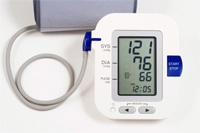This news item expired on Sunday, June 30, 2013 so the information below could be outdated or incorrect.
High blood pressure, or hypertension, is the most common  chronic adult illness in the United States. There is no cure for high blood pressure, but it can be controlled.
chronic adult illness in the United States. There is no cure for high blood pressure, but it can be controlled.
High blood pressure is one of the three major controllable risk factors for cardiovascular disease (risk relates not only to how high your blood pressure is but also to how long it has been raised).
Controlling your blood pressure can also reduce your risk of kidney disease. The sooner your blood pressure is controlled, the less you risk future problems.
Causes
High blood pressure can be hereditary. It can also be caused by a number of lifestyle factors, such as being overweight, smoking, or drinking excessive amounts of alcohol. A small number of people have secondary hypertension, which is high blood pressure caused by organ problems or disease.
Treatment
Two numbers are used to measure your blood pressure: for example, 130 (systolic) over 85 (diastolic). The higher number, the systolic pressure, refers to the pressure inside the artery when the heart squeezes to pump blood through the body. The lower number, the diastolic pressure, refers to the pressure inside the artery when the heart is relaxed and filling with blood. You have hypertension if your systolic pressure is consistently 140 or greater and/or your diastolic pressure is consistently 90 or greater.
Treatment decisions are based on your blood pressure measurement, presence or absence of heart or kidney damage, and presence of other risk factors. Your doctor may give you medications right away or may try a period of lifestyle changes (such as regular exercise or change in diet) for up to 1 year. Depending on your treatment plan and medications prescribed, your doctor will tell you how often to have your blood pressure checked.
Self-Care Steps for High Blood Pressure
Reduce high blood pressure and cardiovascular risks by:
-
Losing weight. Being overweight increases your risk of developing high blood pressure. A weight loss of 5 to 10 pounds can lower and help control blood pressure. Weight loss can also decrease blood cholesterol, triglycerides, and blood sugar levels. Weight loss is the most effective method for controlling hypertension without medication.
-
Exercising regularly. Regular aerobic exercise -- such as walking, running, bicycling, or swimming laps -- can prevent and reduce high blood pressure. More activity can also help reduce weight and stress. Experts recommend 30 to 60 minutes of aerobic exercise as many days of the week as possible.
-
Controlling salt in your diet. Limit sodium to less than 2400 milligrams per day by not adding salt to food, and limiting processed, convenience, and fast foods.
-
Limiting alcohol. Drinking too much alcohol can raise blood pressure, add weight, and make blood pressure control more difficult. Avoid alcohol or limit yourself to two drinks a day for men, and one drink a day for women. A drink is defined as 12 ounces of beer, 4 ounces of wine, or 1 ounce of 100-proof liquor.
-
Increasing potassium intake. A high intake of potassium may improve your blood pressure control. Not getting enough potassium may actually increase blood pressure. Many fruits and vegetables are good sources of potassium -- try to eat at least five servings a day.
-
Quitting smoking. Smoking cigarettes does not cause chronic high blood pressure, but smoking is a major risk factor for cardiovascular disease.
-
Eating less fat. Evidence shows a low-fat diet may lower blood cholesterol and the risk for coronary artery disease. Eating less fat will also aid in weight loss.
-
Taking your medications. If your doctor prescribes medication, take it as directed. Discuss any side effects or reactions you experience with your doctor. Do not stop taking medications without talking to your doctor.
-
Seeing your doctor regularly. After your blood pressure is controlled, you should continue to have it checked regularly. There usually are not symptoms to tell you if your blood pressure is elevated. See your doctor at least once a year to make sure your blood pressure is under control.
To confirm a hypertension diagnosis, your doctor will need blood pressure readings from two or more visits. The data below outlines blood pressure classifications and the different stages of hypertension.
|
Category |
Systolic
(Top Number) |
Diastolic
(Bottom Number) |
|
Normal |
<120 |
<80 |
|
Prehypertension |
120-139 |
80-89 |
|
Stage 1 hypertension |
140-159 |
90-99 |
|
Stage 2 hypertension |
160 or greater |
100 or greater |
Well Advised Library Health Ink and Vitality Communications ©2013